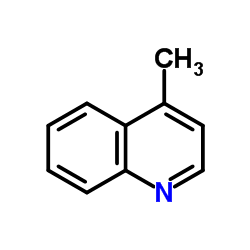Spectroscopic studies on 2-[2-(4-methylquinolin-2-yl)hydrazono]-1,2-diphenylethanone molecule and its metal complexes.
H S Seleem, G A El-Inany, M Mousa, F I Hanafy
Index: Spectrochim. Acta. A. Mol. Biomol. Spectrosc. 74(4) , 869-74, (2009)
Full Text: HTML
Abstract
The electronic absorption spectra of a hydrazone: 2-[2-(4-methylquinolin-2-yl)hydrazono]-1,2-diphenylethanone (BHQ) derived from 2-hydrazino-4-methylquinoline and 1,2-diphenylethan-1,2-dione (benzil) have been studied in various solvents of different polarities. The dependence of the band shift Deltaupsilon on the solvent parameters viz.D, Z, E(T), DN, AN, alpha, beta and pi* was discussed. Also, the effect of pH on the free hydrazone and its Co(II), Ni(II) and Cu(II) complexes was studied spectrophotometrically in 75% (v/v) dioxane-water in order to determine the dissociation and stability constants. The stoichiometry of the formed complexes was determined by three different methods: Job's, mole ratio and slope ratio which indicate the formation of 1:2, M:L complexes for Co(II) and Cu(II) and 1:1, Ni(II):L. Beer's law is valid in the range 0.32-7.04 microg/mL depending on the type of the metal ion. The use of BHQ as an indicator via a spectrophotometric titration of Cu(II) and Ni(II) with EDTA was efficient.
Related Compounds
| Structure | Name/CAS No. | Molecular Formula | Articles |
|---|---|---|---|
 |
lepidine
CAS:491-35-0 |
C10H9N |
|
Time-of-flight accurate mass spectrometry identification of ...
2015-08-01 [Anal. Bioanal. Chem 407 , 6159-70, (2015)] |
|
Direct, catalytic, and regioselective synthesis of 2-alkyl-,...
2014-02-07 [Org. Lett. 16(3) , 864-7, (2014)] |
|
A Programmed DNA Marker Based on Bis(4-ethynyl-1,8-naphthali...
2015-11-09 [Chemistry 21 , 16623-30, (2015)] |
|
Microbial metabolism of quinoline and related compounds. XIX...
1993-07-01 [Biol. Chem. Hoppe-Seyler 374 , 479-488, (1993)] |
|
Carcinogenicity of quinoline, 4- and 8-methylquinoline and b...
1988-07-01 [Food Chem. Toxicol. 26(7) , 625-9, (1988)] |